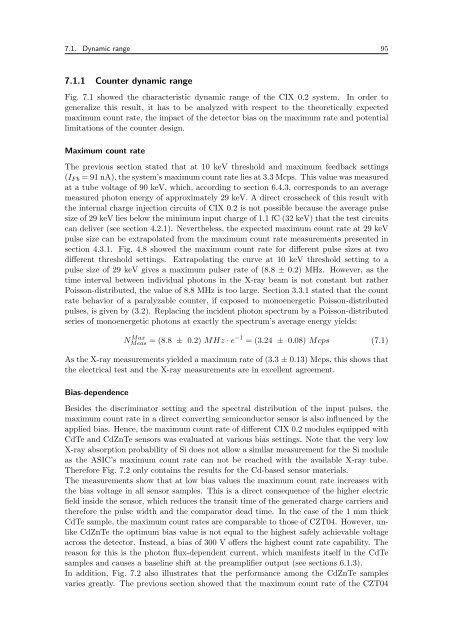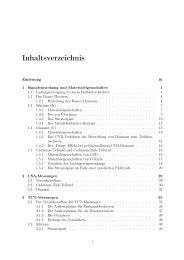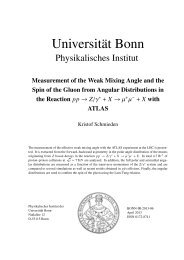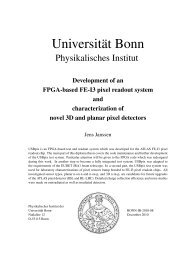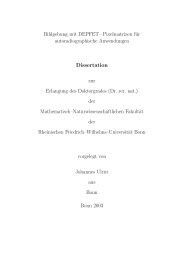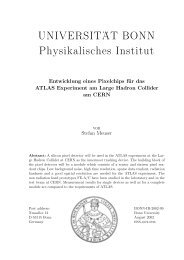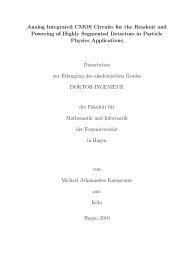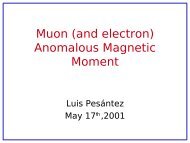UNIVERSIT . . AT BONN Physikalisches Institut - Prof. Dr. Norbert ...
UNIVERSIT . . AT BONN Physikalisches Institut - Prof. Dr. Norbert ...
UNIVERSIT . . AT BONN Physikalisches Institut - Prof. Dr. Norbert ...
Create successful ePaper yourself
Turn your PDF publications into a flip-book with our unique Google optimized e-Paper software.
7.1. Dynamic range 95<br />
7.1.1 Counter dynamic range<br />
Fig. 7.1 showed the characteristic dynamic range of the CIX 0.2 system. In order to<br />
generalize this result, it has to be analyzed with respect to the theoretically expected<br />
maximum count rate, the impact of the detector bias on the maximum rate and potential<br />
limitations of the counter design.<br />
Maximum count rate<br />
The previous section stated that at 10 keV threshold and maximum feedback settings<br />
(IF b = 91 nA), the system’s maximum count rate lies at 3.3 Mcps. This value was measured<br />
at a tube voltage of 90 keV, which, according to section 6.4.3, corresponds to an average<br />
measured photon energy of approximately 29 keV. A direct crosscheck of this result with<br />
the internal charge injection circuits of CIX 0.2 is not possible because the average pulse<br />
size of 29 keV lies below the minimum input charge of 1.1 fC (32 keV) that the test circuits<br />
can deliver (see section 4.2.1). Nevertheless, the expected maximum count rate at 29 keV<br />
pulse size can be extrapolated from the maximum count rate measurements presented in<br />
section 4.3.1. Fig. 4.8 showed the maximum count rate for different pulse sizes at two<br />
different threshold settings. Extrapolating the curve at 10 keV threshold setting to a<br />
pulse size of 29 keV gives a maximum pulser rate of (8.8 ± 0.2) MHz. However, as the<br />
time interval between individual photons in the X-ray beam is not constant but rather<br />
Poisson-distributed, the value of 8.8 MHz is too large. Section 3.3.1 stated that the count<br />
rate behavior of a paralyzable counter, if exposed to monoenergetic Poisson-distributed<br />
pulses, is given by (3.2). Replacing the incident photon spectrum by a Poisson-distributed<br />
series of monoenergetic photons at exactly the spectrum’s average energy yields:<br />
N Max<br />
Meas = (8.8 ± 0.2) MHz · e −1 = (3.24 ± 0.08) Mcps (7.1)<br />
As the X-ray measurements yielded a maximum rate of (3.3 ± 0.13) Mcps, this shows that<br />
the electrical test and the X-ray measurements are in excellent agreement.<br />
Bias-dependence<br />
Besides the discriminator setting and the spectral distribution of the input pulses, the<br />
maximum count rate in a direct converting semiconductor sensor is also influenced by the<br />
applied bias. Hence, the maximum count rate of different CIX 0.2 modules equipped with<br />
CdTe and CdZnTe sensors was evaluated at various bias settings. Note that the very low<br />
X-ray absorption probability of Si does not allow a similar measurement for the Si module<br />
as the ASIC’s maximum count rate can not be reached with the available X-ray tube.<br />
Therefore Fig. 7.2 only contains the results for the Cd-based sensor materials.<br />
The measurements show that at low bias values the maximum count rate increases with<br />
the bias voltage in all sensor samples. This is a direct consequence of the higher electric<br />
field inside the sensor, which reduces the transit time of the generated charge carriers and<br />
therefore the pulse width and the comparator dead time. In the case of the 1 mm thick<br />
CdTe sample, the maximum count rates are comparable to those of CZT04. However, unlike<br />
CdZnTe the optimum bias value is not equal to the highest safely achievable voltage<br />
across the detector. Instead, a bias of 300 V offers the highest count rate capability. The<br />
reason for this is the photon flux-dependent current, which manifests itself in the CdTe<br />
samples and causes a baseline shift at the preamplifier output (see sections 6.1.3).<br />
In addition, Fig. 7.2 also illustrates that the performance among the CdZnTe samples<br />
varies greatly. The previous section showed that the maximum count rate of the CZT04


